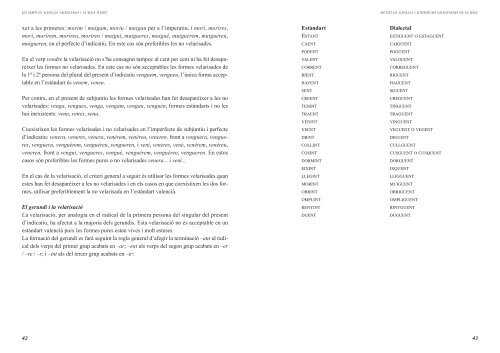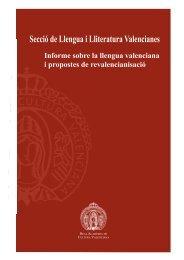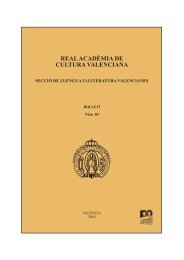els verps en llengua valenciana i la seua flexió - Secció de Llengua ...
els verps en llengua valenciana i la seua flexió - Secció de Llengua ...
els verps en llengua valenciana i la seua flexió - Secció de Llengua ...
Create successful ePaper yourself
Turn your PDF publications into a flip-book with our unique Google optimized e-Paper software.
ELS VERPS EN LLENGUA VALENCIANA I LA SEUA FLEXIÓ<br />
xer a les primeres: morim / muigam, moriu / muigau per a l’imperatiu, i morí, morires,<br />
morí, morírem, moríreu, morir<strong>en</strong> / muiguí, muigueres, muigué, muiguérem, muiguéreu,<br />
muiguer<strong>en</strong>, <strong>en</strong> el perfecte d’indicatiu. En este cas són preferibles les no ve<strong>la</strong>risa<strong>de</strong>s.<br />
En el verp v<strong>en</strong>dre <strong>la</strong> ve<strong>la</strong>risació no s’ha consagrat tampoc al c<strong>en</strong>t per c<strong>en</strong>t ni ha fet <strong>de</strong>saparéixer<br />
les formes no ve<strong>la</strong>risa<strong>de</strong>s. En este cas no són acceptables les formes ve<strong>la</strong>risa<strong>de</strong>s <strong>de</strong><br />
<strong>la</strong> 1ª i 2ª persona <strong>de</strong>l plural <strong>de</strong>l pres<strong>en</strong>t d’indicatiu v<strong>en</strong>guem, v<strong>en</strong>gueu, l’única forma acceptable<br />
<strong>en</strong> l’estàndart és v<strong>en</strong>em, v<strong>en</strong>eu.<br />
Per contra, <strong>en</strong> el pres<strong>en</strong>t <strong>de</strong> subjuntiu les formes ve<strong>la</strong>risa<strong>de</strong>s han fet <strong>de</strong>saparéixer a les no<br />
ve<strong>la</strong>risa<strong>de</strong>s: v<strong>en</strong>ga, v<strong>en</strong>gues, v<strong>en</strong>ga, v<strong>en</strong>gam, v<strong>en</strong>gau, v<strong>en</strong>gu<strong>en</strong>, formes estàndarts i no les<br />
hui inexist<strong>en</strong>ts: v<strong>en</strong>a, v<strong>en</strong>es, v<strong>en</strong>a.<br />
Coexistix<strong>en</strong> les formes ve<strong>la</strong>risa<strong>de</strong>s i no ve<strong>la</strong>risa<strong>de</strong>s <strong>en</strong> l’imperfecte <strong>de</strong> subjuntiu i perfecte<br />
d’indicatiu: v<strong>en</strong>era, v<strong>en</strong>eres, v<strong>en</strong>era, v<strong>en</strong>érem, v<strong>en</strong>éreu, v<strong>en</strong>er<strong>en</strong>, front a v<strong>en</strong>guera, v<strong>en</strong>gueres,<br />
v<strong>en</strong>guera, v<strong>en</strong>guérem, v<strong>en</strong>guéreu, v<strong>en</strong>guer<strong>en</strong>, i v<strong>en</strong>í, v<strong>en</strong>eres, v<strong>en</strong>é, v<strong>en</strong>érem, v<strong>en</strong>éreu,<br />
v<strong>en</strong>er<strong>en</strong>, front a v<strong>en</strong>guí, v<strong>en</strong>gueres, v<strong>en</strong>gué, v<strong>en</strong>guérem, v<strong>en</strong>guéreu, v<strong>en</strong>guer<strong>en</strong>. En estos<br />
casos són preferibles les formes pures o no ve<strong>la</strong>risa<strong>de</strong>s v<strong>en</strong>era... i v<strong>en</strong>í...<br />
En el cas <strong>de</strong> <strong>la</strong> ve<strong>la</strong>risació, el criteri g<strong>en</strong>eral a seguir és utilisar les formes ve<strong>la</strong>risa<strong>de</strong>s quan<br />
estes han fet <strong>de</strong>saparéixer a les no ve<strong>la</strong>risa<strong>de</strong>s i <strong>en</strong> <strong>els</strong> casos <strong>en</strong> que coexistix<strong>en</strong> les dos formes,<br />
utilisar preferiblem<strong>en</strong>t <strong>la</strong> no ve<strong>la</strong>risada <strong>en</strong> l’estàndart val<strong>en</strong>cià.<br />
El gerundi i <strong>la</strong> ve<strong>la</strong>risació<br />
La ve<strong>la</strong>risació, per analogia <strong>en</strong> el radical <strong>de</strong> <strong>la</strong> primera persona <strong>de</strong>l singu<strong>la</strong>r <strong>de</strong>l pres<strong>en</strong>t<br />
d’indicatiu, ha afectat a <strong>la</strong> majoria d<strong>els</strong> gerundis. Esta ve<strong>la</strong>risació no és acceptable <strong>en</strong> un<br />
estàndart val<strong>en</strong>cià puix les formes pures estan vives i molt esteses.<br />
La formació <strong>de</strong>l gerundi es farà seguint <strong>la</strong> reg<strong>la</strong> g<strong>en</strong>eral d’afegir <strong>la</strong> terminació –ant al radical<br />
d<strong>els</strong> <strong>verps</strong> <strong>de</strong>l primer grup acabats <strong>en</strong> –ar; –<strong>en</strong>t als <strong>verps</strong> <strong>de</strong>l segon grup acabats <strong>en</strong> –er<br />
/ –re / –r; i –int als <strong>de</strong>l tercer grup acabats <strong>en</strong> –ir:<br />
42<br />
Estàndart Dialectal<br />
SECCIÓ DE LLENGUA I LLITERATURA VALENCIANES DE LA RACV<br />
ESTANT ESTIGUENT O ESTAGUENT<br />
CAENT CAIGUENT<br />
PODENT POGUENT<br />
VALENT VALGUENT<br />
CORRENT CORREGUENT<br />
RIENT RIGUENT<br />
HAVENT HAGUENT<br />
SENT SIGUENT<br />
CREENT CREGUENT<br />
TENINT TINGUENT<br />
TRAENT TRAGUENT<br />
VENINT VINGUENT<br />
VEENT VEGUENT O VEGENT<br />
DIENT DIGUENT<br />
COLLINT CULLGUENT<br />
COSINT CUSGUENT O CUSQUENT<br />
DORMINT DORGUENT<br />
EIXINT IXQUENT<br />
LLEGINT LLIGGUENT<br />
MORINT MUIGUENT<br />
OBRINT OBRIGUENT<br />
OMPLINT OMPLIGUENT<br />
RENYINT RINYGUENT<br />
DUENT DUGUENT<br />
43




